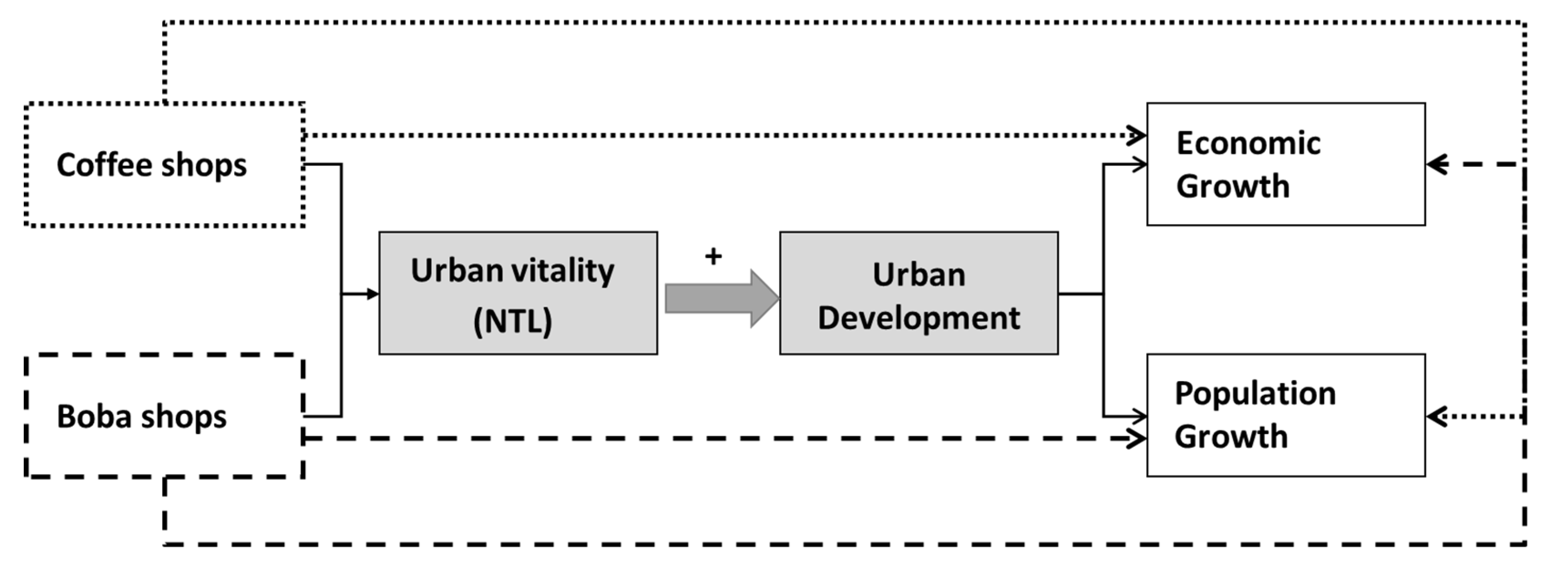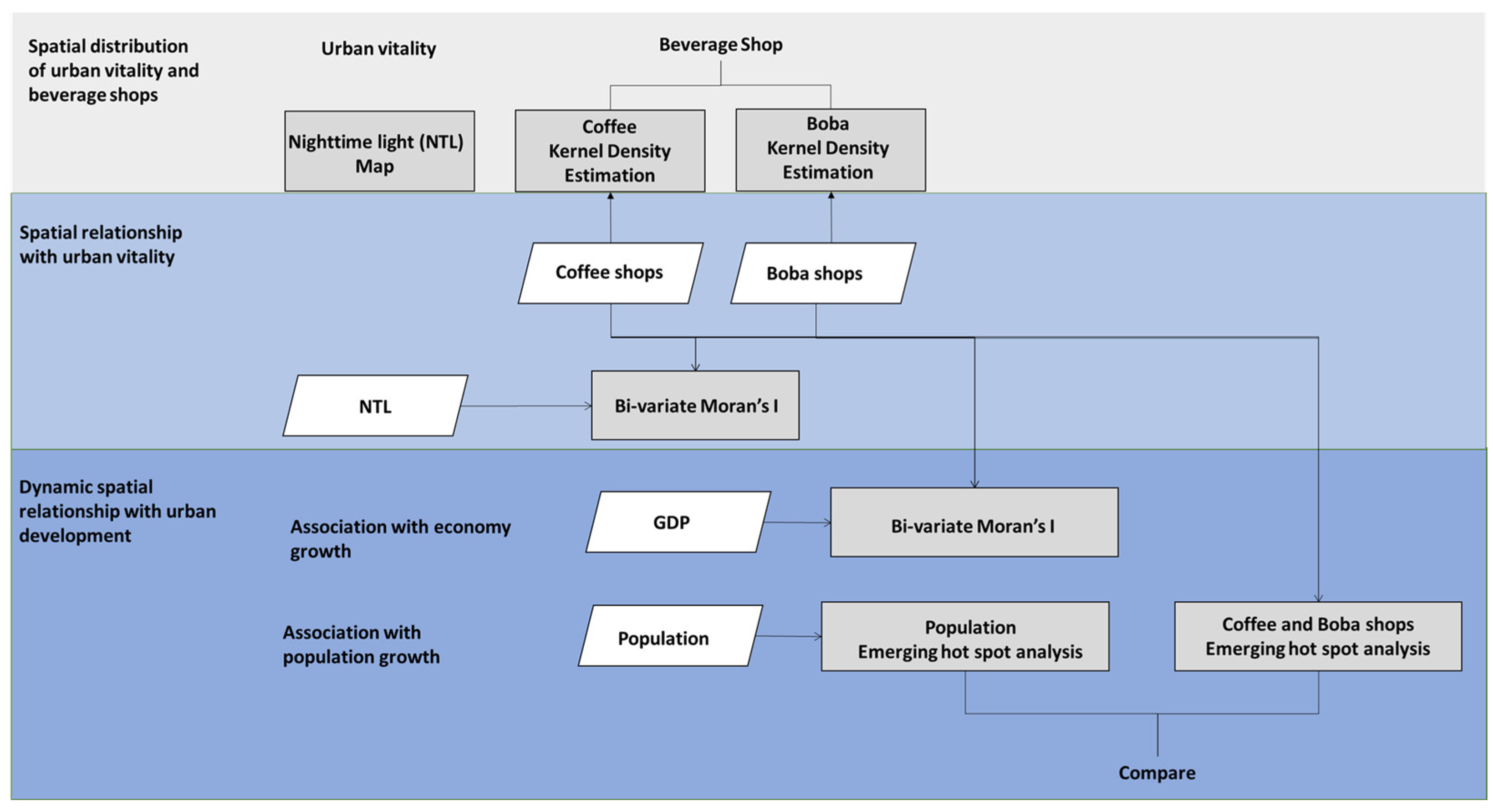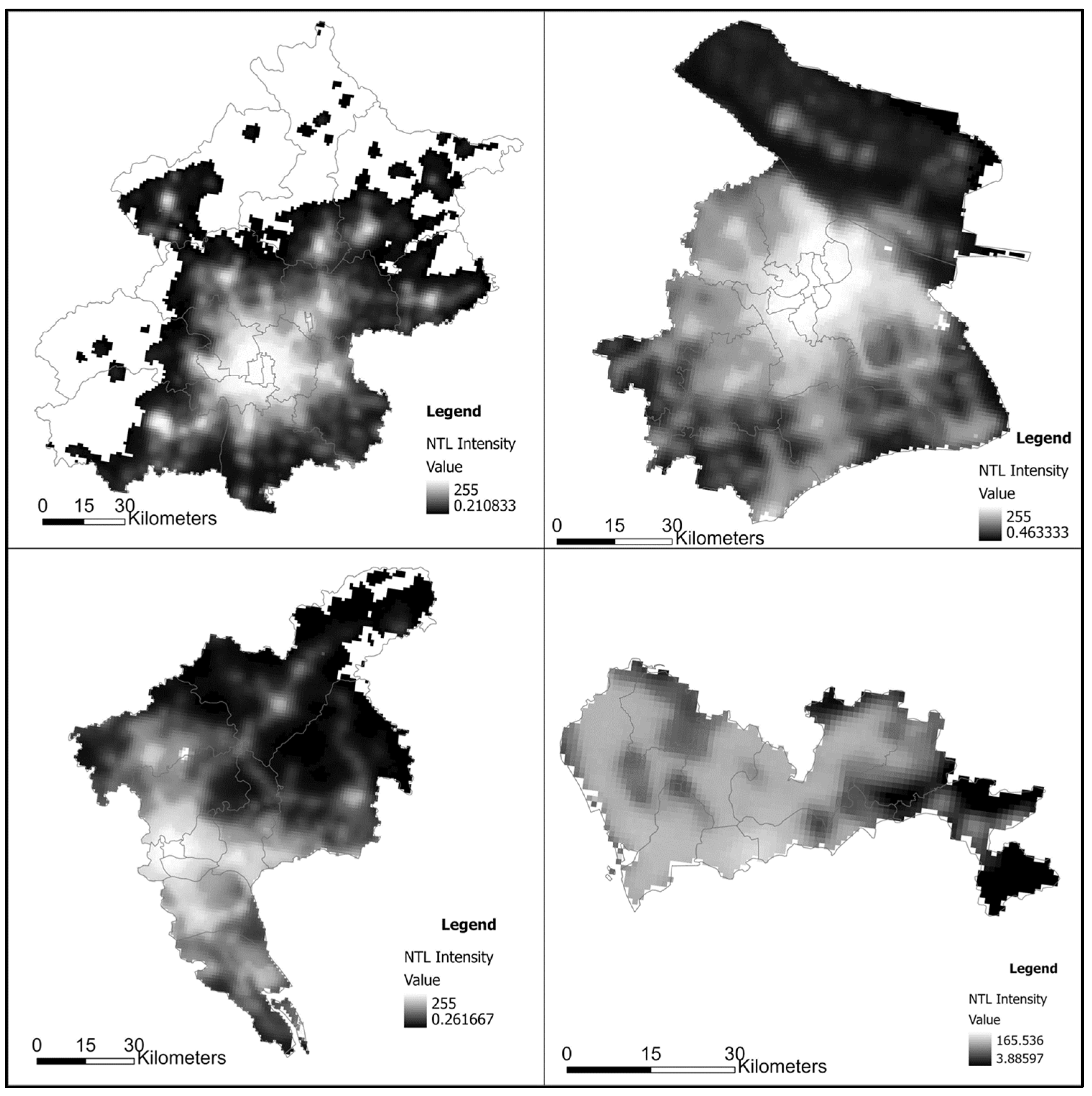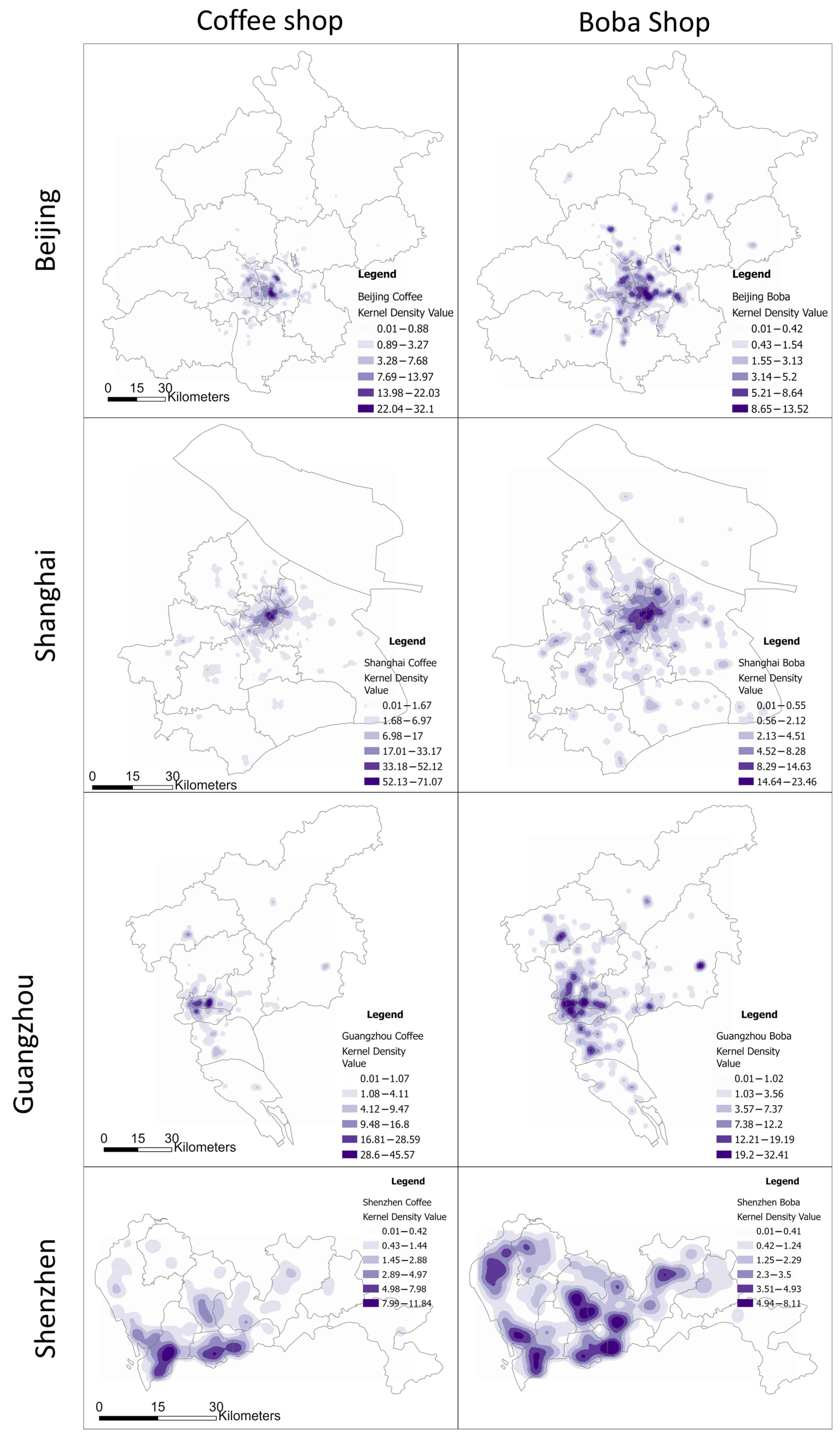Boba Shop, Coffee Shop, and Urban Vitality and Development—A Spatial Association and Temporal Analysis of Major Cities in China from the Standpoint of Nighttime Light
Abstract
1. Introduction
1.1. What Is Urban Vitality?
1.2. Using NTL and Other Data to Measure Urban Vitality
1.3. Small Catering Businesses and Urban Vitality
1.4. Research Gap of Boba Shops, Urban Vitality, and Urban Development
2. Materials and Methods
2.1. Study Area
2.2. Study Data
2.2.1. Longitudinal Nighttime Light Data 2012–2020
2.2.2. Longitudinal POI Data (2012–2022)
2.2.3. Longitudinal Kilometer Spatial Grid GDP and Population Data 2010–2020
2.3. Study Method
2.3.1. Kernel Density Analysis
2.3.2. Bivariate Moran’s I Analysis
2.3.3. Emerging Hot Spot Analysis
3. Results
3.1. Spatial Distribution of Urban Vitality Represented by Nighttime Light (NTL)
3.2. Heterogenous Spatial Distribution of Beverage Shops
3.3. Beverage Shops and Urban Vitality Represented by NTL
3.3.1. Global Bivariate Spatial Relationship with NTL throughout 2012–2020
3.3.2. Local Bivariate Spatial Relationship with NTL in 2020
3.4. Boba Shops, Coffee Shops and Urban Development
3.4.1. Economic Development
3.4.2. Population Growth
4. Discussion
5. Conclusions
- (1)
- The urban vitality indicated by NTL is highly concentrated in urban centers, regions with the most intense economic activities, and coffee shops have a similar spatial distribution, while boba shops have a larger spatial extent in urban peripheries.
- (2)
- Both boba and coffee shops can represent urban vitality. In Beijing, a political and educational hub teeming with high talent, the spatial distribution of coffee shops better captures urban vitality than boba shops, while in Guangzhou and Shenzhen, cities with a high proportion of migrant workers, boba shops better capture urban vitality than coffee shops.
- (3)
- Within the four megacities, the spatial expansion of coffee shops during the past ten years corresponds to locations with the most intense economic growth, whereas the spatial expansion of boba shops corresponds to places with a rapid population rise.
Author Contributions
Funding
Data Availability Statement
Conflicts of Interest
References
- Chen, Z.; Dong, B.; Pei, Q.; Zhang, Z. The impacts of urban vitality and urban density on innovation: Evidence from China’s Greater Bay Area. Habitat Int. 2021, 119, 102490. [Google Scholar] [CrossRef]
- Jacobs, J. The Death and Life of Great American Cities; Random House: New York, NY, USA, 1961. [Google Scholar]
- Li, M.; Shen, Z.; Hao, X. Revealing the relationship between spatio-temporal distribution of population and urban function with social media data. Geojournal 2016, 81, 919–935. [Google Scholar] [CrossRef]
- Lynch, K. Good City Form; MIT Press: Cambridge, MA, USA, 1984. [Google Scholar]
- Yue, W.; Chen, Y.; Thy, P.T.M.; Fan, P.; Liu, Y.; Zhang, W. Identifying urban vitality in metropolitan areas of developing countries from a comparative perspective: Ho Chi Minh City versus Shanghai. Sustain. Cities Soc. 2020, 65, 102609. [Google Scholar] [CrossRef]
- Zhang, A.; Li, W.; Wu, J.; Lin, J.; Chu, J.; Xia, C. How can the urban landscape affect urban vitality at the street block level? A case study of 15 metropolises in China. Environ. Plan. B Urban Anal. City Sci. 2020, 48, 1245–1262. [Google Scholar] [CrossRef]
- Gehl, J. Life between Buildings; Van Nostrand Reinhold: Washington, DC, USA, 1987. [Google Scholar]
- Montgomery, J. Making a city: Urbanity, vitality and urban design. J. Urban Des. 2007, 3, 93–116. [Google Scholar] [CrossRef]
- Long, Y.; Huang, C.C. Does block size matter? The impact of urban design on economic vitality for Chinese cities. SAGE J. 2017, 46, 406–422. [Google Scholar] [CrossRef]
- Ye, Y.; Li, D.; Liu, X. How block density and typology affect urban vitality: An exploratory analysis in Shenzhen, China. Urban Geogr. 2018, 39, 631–652. [Google Scholar] [CrossRef]
- Braun, L.M.; Malizia, E. Downtown vibrancy influences public health and safety outcomes in urban counties. J. Transp. Health 2015, 2, 540–548. [Google Scholar] [CrossRef]
- He, Q.S.; He, W.S.; Song, Y.; Wu, J.Y.; Yin, C.H.; Mou, Y.C. The impact of urban growth patterns on urban vitality in newly built-up areas based on an association rules analysis using geographical ‘big data’. Land Use Policy 2018, 78, 726–738. [Google Scholar] [CrossRef]
- Landry, C. Urban Vitality: A New Source of Urban Competitiveness. Archis 2000, 12, 8–13. [Google Scholar]
- Li, S.-M.; Liu, Y. The jobs-housing relationship and commuting in Guangzhou, China: Hukou and dual structure. J. Transp. Geogr. 2016, 54, 286–294. [Google Scholar] [CrossRef]
- Mouratidis, K.; Poortinga, W. Built environment, urban vitality and social cohesion: Do vibrant neighborhoods foster strong communities? Landsc. Urban Plan. 2020, 204, 103951. [Google Scholar] [CrossRef]
- Brenner, N. Implosions/Explosions; Jovis: Capri, Italy, 2014. [Google Scholar]
- Hall, P.; Pfeiffer, U. Urban Future 21: A Global Agenda for Twenty-First Century Cities; Routledge: London, UK, 2013. [Google Scholar] [CrossRef]
- Stead, D.; Hoppenbrouwer, E. Promoting an urban renaissance in England and the Netherlands. Cities 2004, 21, 119–136. [Google Scholar] [CrossRef]
- Woodworth, M.D.; Wallace, J.L. Seeing ghosts: Parsing China’s “ghost city” controversy. Urban Geogr. 2017, 38, 1270–1281. [Google Scholar] [CrossRef]
- Haas, J.; Ban, Y. Urban growth and environmental impacts in Jing-Jin-Ji, the Yangtze, River Delta and the Pearl River Delta. Int. J. Appl. Earth Obs. Geoinf. 2014, 30, 42–55. [Google Scholar] [CrossRef]
- Zhang, Y.; Xie, H. Interactive Relationship among Urban Expansion, Economic Development, and Population Growth since the Reform and Opening up in China: An Analysis Based on a Vector Error Correction Model. Land 2019, 8, 153. [Google Scholar] [CrossRef]
- Zhu, X.; Zhang, P.; Wei, Y.; Li, Y.; Zhao, H. Measuring the efficiency and driving factors of urban land use based on the DEA method and the PLS-SEM model—A case study of 35 large and medium-sized cities in China. Sustain. Cities Soc. 2019, 50, 101646. [Google Scholar] [CrossRef]
- Huang, Y. Urban Development in Contemporary China. In China’s Geography: Globalization and the Dynamics of Political, Economic and Social Change; Roman & Littlefield Publishers: Lanham, MD, USA, 2006; pp. 233–262. [Google Scholar]
- Elvidge, C.D.; Baugh, K.E.; Kihn, E.A.; Kroehl, H.W.; Davis, E.R.; Davis, C.W. Relation between satellite observed visible-near infrared emissions, population, economic activity and electric power consumption. Int. J. Remote. Sens. 1997, 18, 1373–1379. [Google Scholar] [CrossRef]
- Li, X.; Xu, H.; Chen, X.; Li, C. Potential of NPP-VIIRS Nighttime Light Imagery for Modeling the Regional Economy of China. Remote. Sens. 2013, 5, 3057–3081. [Google Scholar] [CrossRef]
- Li, X.; Levin, N.; Xie, J.; Li, D. Monitoring hourly night-time light by an unmanned aerial vehicle and its implications to satellite remote sensing. Remote. Sens. Environ. 2020, 247, 111942. [Google Scholar] [CrossRef]
- Zhang, J.; Liu, X.; Tan, X.; Jia, T.; Senousi, A.M.; Huang, J.; Yin, L.; Zhang, F. Nighttime Vitality and Its Relationship to Urban Diversity: An Exploratory Analysis in Shenzhen, China. IEEE J. Sel. Top. Appl. Earth Obs. Remote. Sens. 2021, 15, 309–322. [Google Scholar] [CrossRef]
- Zikirya, B.; He, X.; Li, M.; Zhou, C. Urban Food Takeaway Vitality: A New Technique to Assess Urban Vitality. Int. J. Environ. Res. Public Health 2021, 18, 3578. [Google Scholar] [CrossRef] [PubMed]
- Bennett, M.M.; Smith, L.C. Advances in using multitemporal night-time lights satellite imagery to detect, estimate, and monitor socioeconomic dynamics. Remote Sens. Environ. 2017, 192, 176–197. [Google Scholar] [CrossRef]
- Hadfield, P. The night-time city. Four modes of exclusion: Reflections on the Urban Studies special collection. SAGE J. 2014, 52, 606–616. [Google Scholar] [CrossRef]
- Wang, L.; Wang, S.; Zhou, Y.; Liu, W.; Hou, Y.; Zhu, J.; Wang, F. Mapping population density in China between 1990 and 2010 using remote sensing. Remote. Sens. Environ. 2018, 210, 269–281. [Google Scholar] [CrossRef]
- Zhang, Q.; Seto, K.C. Mapping urbanization dynamics at regional and global scales using multi-temporal DMSP/OLS nighttime light data. Remote. Sens. Environ. 2011, 115, 2320–2329. [Google Scholar] [CrossRef]
- Dai, Z.; Hu, Y.; Zhao, G. The Suitability of Different Nighttime Light Data for GDP Estimation at Different Spatial Scales and Regional Levels. Sustainability 2017, 9, 305. [Google Scholar] [CrossRef]
- Doll, C.N.; Muller, J.-P.; Morley, J.G. Mapping regional economic activity from night-time light satellite imagery. Ecol. Econ. 2006, 57, 75–92. [Google Scholar] [CrossRef]
- Huang, Q.; Yang, Y.; Li, Y.; Gao, B. A Simulation Study on the Urban Population of China Based on Nighttime Light Data Acquired from DMSP/OLS. Sustainability 2016, 8, 521. [Google Scholar] [CrossRef]
- Sutton, P.C.; Elvidge, C.D.; Ghosh, T. Estimation of gross domestic product at sub-national scales using nighttime satellite imagery. Int. J. Ecol. Econ. Stat. 2007, 8, 5–21. [Google Scholar]
- Xie, Y.; Weng, Q. Spatiotemporally enhancing time-series DMSP/OLS nighttime light imagery for assessing large-scale urban dynamics. ISPRS J. Photogramm. Remote. Sens. 2017, 128, 1–15. [Google Scholar] [CrossRef]
- Lan, F.; Gong, X.; Da, H.; Wen, H. How do population inflow and social infrastructure affect urban vitality? Evidence from 35 large- and medium-sized cities in China. Cities 2020, 100, 102454. [Google Scholar] [CrossRef]
- Jin, X.; Long, Y.; Sun, W.; Lu, Y.; Yang, X.; Tang, J. Evaluating cities’ vitality and identifying ghost cities in China with emerging geographical data. Cities 2017, 63, 98–109. [Google Scholar] [CrossRef]
- Wu, W.; Niu, X. Influence of Built Environment on Urban Vitality: Case Study of Shanghai Using Mobile Phone Location Data. J. Urban Plan. Dev. 2019, 145, 04019007. [Google Scholar] [CrossRef]
- Sulis, P.; Manley, E.; Zhong, C.; Batty, M. Using mobility data as proxy for measuring urban vitality. J. Spat. Inf. Sci. 2018, 16, 137–162. [Google Scholar] [CrossRef]
- Wu, J.; Ta, N.; Song, Y.; Lin, J.; Chai, Y. Urban form breeds neighborhood vibrancy: A case study using a GPS-based activity survey in suburban Beijing. Cities 2018, 74, 100–108. [Google Scholar] [CrossRef]
- Sung, H.; Lee, S. Residential built environment and walking activity: Empirical evidence of Jane Jacobs’ urban vitality. Transp. Res. Part D: Transp. Environ. 2015, 41, 318–329. [Google Scholar] [CrossRef]
- Yue, Y.; Zhuang, Y.; Yeh, A.G.-O.; Xie, J.-Y.; Ma, C.-L.; Li, Q.-Q. Measurements of POI-based mixed use and their relationships with neighbourhood vibrancy. Int. J. Geogr. Inf. Sci. 2017, 31, 658–675. [Google Scholar] [CrossRef]
- Yang, J.; Cao, J.; Zhou, Y. Elaborating non-linear associations and synergies of subway access and land uses with urban vitality in Shenzhen. Transp. Res. Part A Policy Pr. 2020, 144, 74–88. [Google Scholar] [CrossRef]
- Montgomery, J. Café culture and the city: The role of pavement cafés in urban public social life. J. Urban Des. 2007, 2, 83–102. [Google Scholar] [CrossRef]
- Zukin, S. Naked City: The Death and Life of Authentic Urban Places; Oxford University Press: Oxford, UK, 2009. [Google Scholar]
- Dong, L.; Ratti, C.; Zheng, S. Predicting neighborhoods’ socioeconomic attributes using restaurant data. Proc. Natl. Acad. Sci. USA 2019, 116, 15447–15452. [Google Scholar] [CrossRef]
- Philipsen, K. How Food Became the Ferment of Urbanity. Community Architecture Website. 2015. Available online: http://archplanbaltimore.blogspot.com/2015/10/how-food-became-ferment-of-urbanity.html (accessed on 1 August 2022).
- Ferreira, J.; Ferreira, C.; Bos, E. Spaces of consumption, connection, and community: Exploring the role of the coffee shop in urban lives. Geoforum 2021, 119, 21–29. [Google Scholar] [CrossRef]
- Oldenburg, R. The Great Good Place: Cafes, Coffee Shops, Bookstores, Bars, Hair Salons, and Other Hangouts at the Heart of a Community; Da Capo Press: Cambridge, MA, USA, 1999. [Google Scholar]
- Ellis, A. The Penny Universities: A History of the Coffee-Houses; Secker & Warburg: London, UK, 1956. [Google Scholar]
- Morris, J. Coffee: A Global History; Reaktion Books: London, UK, 2018. [Google Scholar]
- Pendergrast, M. Uncommon grounds: The History of Coffee and how it Transformed Our World; Basic Books: New York, NY, USA, 2010. [Google Scholar]
- Landry, C. The Creative City: A Toolkit for Urban Innovators; Routledge: London, UK, 2012. [Google Scholar] [CrossRef]
- Maas, P.R. Towards a Theory of Urban Vitality; University of British Columbia: Vancouver, BC, Canada, 1984. [Google Scholar] [CrossRef]
- Di Marino, M.; Lapintie, K. Emerging Workplaces in Post-Functionalist Cities. J. Urban Technol. 2017, 24, 5–25. [Google Scholar] [CrossRef]
- Smith, R.F. A History of Coffee. In Coffee; Springer: Boston, MA, USA, 1985; pp. 1–12. [Google Scholar] [CrossRef]
- Min, J.E.; Green, D.B.; Kim, L. Calories and sugars in boba milk tea: Implications for obesity risk in Asian Pacific Islanders. Food Sci. Nutr. 2016, 5, 38–45. [Google Scholar] [CrossRef] [PubMed]
- Fortune Business Insights. Bubble Tea Market Size, Industry Trends | Analysis Report, 2027. Market Res. Rep. 2019. Available online: https://www.fortunebusinessinsights.com/industry-reports/bubble-tea-market-101564 (accessed on 1 August 2022).
- Foster, J. Caffeine (Coffee) Consumption By Country. 2022. Available online: https://www.caffeineinformer.com/caffeine-what-the-world-drinks (accessed on 1 August 2022).
- Reyes, C.M.; Cornelis, M.C. Caffeine in the Diet: Country-Level Consumption and Guidelines. Nutrients 2018, 10, 1772. [Google Scholar] [CrossRef] [PubMed]
- Luo, W. Tea Time Rides Bubbles of New Popularity|Business|China Daily. 2020. Available online: https://www.chinadailyhk.com/article/151386#Tea-time-rides-bubbles-of-new-popularity (accessed on 1 August 2022).
- Wang, Z. Taiwanese Bubble Tea Chain Characteristics and Strategic Analysis of Branding Challenges in China’s Customized Beverage Industry. Sport. Exerc. Res. 2019, 12, 1–76. (In Chinese) [Google Scholar] [CrossRef]
- Pandaily. Nayuki Tea Releases First Financial Report After IPO—Pandaily. 2021. Available online: https://pandaily.com/nayuki-tea-releases-first-financial-report-after-ipo/ (accessed on 1 August 2022).
- Xu, V. Bubble Tea Brand MXBC Goes Viral 24 Years After Creation—What’s In the Recipe?—Pandaily. 2021. Available online: https://pandaily.com/bubble-tea-brand-mxbc-goes-viral-24-years-after-creation-whats-in-the-recipe/ (accessed on 1 August 2022).
- Lei, S.; Lei, S. Repurchase Behavior of College Students in Boba Tea Shops: A Review of Literature. Coll. Stud. J. 2020, 53, 465–473. [Google Scholar]
- Wu, Y.; Lu, Y.; Xie, G. Bubble tea consumption and its association with mental health symptoms: An observational cross-sectional study on Chinese young adults. J. Affect. Disord. 2021, 299, 620–627. [Google Scholar] [CrossRef]
- National Bureau of Statistics. (n.d.). National Data. Available online: https://data.stats.gov.cn/index.htm (accessed on 31 December 2022).
- Liu, G.; Yang, Z.; Chen, B.; Ulgiati, S. Monitoring trends of urban development and environmental impact of Beijing, 1999–2006. Sci. Total Environ. 2011, 409, 3295–3308. [Google Scholar] [CrossRef] [PubMed]
- Shi, J.; Miao, W.; Si, H.; Liu, T. Urban Vitality Evaluation and Spatial Correlation Research: A Case Study from Shanghai, China. Land 2021, 10, 1195. [Google Scholar] [CrossRef]
- Gong, J.; Chen, W.; Liu, Y.; Wang, J. The intensity change of urban development land: Implications for the city master plan of Guangzhou, China. Land Use Policy 2014, 40, 91–100. [Google Scholar] [CrossRef]
- Zhao, M.; Zhou, Y.; Li, X.; Cao, W.; He, C.; Yu, B.; Elvidge, C.D.; Cheng, W. Applications of Satellite Remote Sensing of Nighttime Light Observations: Advances, Challenges, and Perspectives. Remote. Sens. 2019, 11, 1971. [Google Scholar] [CrossRef]
- Zheng, Q.; Weng, Q.; Wang, K. Developing a new cross-sensor calibration model for DMSP-OLS and Suomi-NPP VIIRS night-light imageries. ISPRS J. Photogramm. Remote. Sens. 2019, 153, 36–47. [Google Scholar] [CrossRef]
- Huang, Y.; Yang, J.; Chen, M.; Wu, C.; Ren, H.; Liu, Y. An Approach for Retrieving Consistent Time Series “Urban Core–Suburban-Rural” (USR) Structure Using Nighttime Light Data from DMSP/OLS and NPP/VIIRS. Remote. Sens. 2022, 14, 3642. [Google Scholar] [CrossRef]
- Zhao, M.; Zhou, Y.; Li, X.; Zhou, C.; Cheng, W.; Li, M.; Huang, K. Building a Series of Consistent Night-Time Light Data (1992–2018) in Southeast Asia by Integrating DMSP-OLS and NPP-VIIRS. IEEE Trans. Geosci. Remote Sens. 2019, 58, 1843–1856. [Google Scholar] [CrossRef]
- Nechaev, D.; Zhizhin, M.; Poyda, A.; Ghosh, T.; Hsu, F.-C.; Elvidge, C. Cross-Sensor Nighttime Lights Image Calibration for DMSP/OLS and SNPP/VIIRS with Residual U-Net. Remote. Sens. 2021, 13, 5026. [Google Scholar] [CrossRef]
- Xu, X. China’s GDP Spatial Distribution in 1 km Grid. Resour. Environ. Sci. Data Cent. 2017. (In Chinese) [Google Scholar] [CrossRef]
- Xu, X. China’s Population Spatial Distribution in 1 km Grid. Resour. Environ. Sci. Data Cent. 2017. (In Chinese) [Google Scholar] [CrossRef]
- Liu, H.; Jiang, D.; Yang, X.; Luo, C. Spatialization Approach to 1 km Grid GDP Supported by Remote Sensing. Geo-Inf. Sci. 2005, 7, 120–123. (In Chinese) [Google Scholar]
- Huang, Y.; Jiang, D.; Fu, J. 1 KM Grid GDP Data of China (2005, 2010). Glob. Change Res. Data Publ. Repos. 2014, 69 (Suppl. S1), 140–143. (In Chinese) [Google Scholar]
- Fu, J.; Jiang, D.; Huang, Y. 1 km grid population dataset of China (2005, 2010). Acta Geogr. Sin. 2014, 69 (Suppl. S1), 136–139. (In Chinese) [Google Scholar]
- Shan, L.; Wang, H.; Zhang, B.; Pan, P. Land Use Simulation of the City Clusters Around Poyang Lake based on Land Ecological Security Assessment. J. Geo-Inf. Sci. 2020, 22, 543–556. (In Chinese) [Google Scholar] [CrossRef]
- Jiao, Y.; Zhao, N.; Yue, T.; Deng, J. The effect of urbanization on extreme climate events in Beijing. Geogr. Res. 2020, 2, 461–472. (In Chinese) [Google Scholar] [CrossRef]
- Kang, Y.; Guo, E.; Wang, Y.; Bao, Y.; Bao, Y.; Mandula, N. Monitoring Vegetation Change and Its Potential Drivers in Inner Mongolia from 2000 to 2019. Remote. Sens. 2021, 13, 3357. [Google Scholar] [CrossRef]
- Silverman, B.W. Density Estimation for Statistics and Data Analysis; Chapman and Hall: London, UK, 1986. [Google Scholar]
- Perry, C. The Neighbourhood Unit (1929) (Reprinted); Routledge: London, UK; Thoemmes: New York, NY, USA, 1998. [Google Scholar]
- Anselin, L. Global Spatial Autocorrelation (2)- Geoda documentation. 2019. Available online: https://geodacenter.github.io/workbook/5b_global_adv/lab5b.html#bivariate-moran-scatter-plot (accessed on 8 May 2022).
- Anselin, L. Local Spatial Autocorrelation (3)- Geoda documentation. 2020. Available online: https://geodacenter.github.io/workbook/6c_local_multi/lab6c.html#bivariate-local-moran (accessed on 8 May 2022).
- Ord, J.K.; Getis, A. Local Spatial Autocorrelation Statistics: Distributional Issues and an Application. Geogr. Anal. 1995, 27, 286–306. [Google Scholar] [CrossRef]
- Kendall, M.G.; Gibbons, J.D. 1990 Rank Correlation Methods; Griffin: New York, NY, USA, 1990. [Google Scholar]
- Mann, H.B. Nonparametric tests against trend. Econometrica 1945, 13, 245. [Google Scholar] [CrossRef]
- Harris, N.L.; Goldman, E.; Gabris, C.; Nordling, J.; Minnemeyer, S.; Ansari, S.; Lippmann, M.; Bennett, L.; Raad, M.; Hansen, M.; et al. Using spatial statistics to identify emerging hot spots of forest loss. Environ. Res. Lett. 2017, 12, 024012. [Google Scholar] [CrossRef]
- How Create Space Time Cube works—ArcGIS Pro | Documentation. (n.d.). Available online: https://pro.arcgis.com/en/pro-app/latest/tool-reference/space-time-pattern-mining/learnmorecreatecube.htm (accessed on 2 November 2022).
- How Emerging Hot Spot Analysis works—ArcGIS Pro | Documentation. (n.d.). Available online: https://pro.arcgis.com/en/pro-app/2.8/tool-reference/space-time-pattern-mining/learnmoreemerging.htm (accessed on 8 May 2022).
- Wang, R.; Wan, B.; Guo, Q.; Hu, M.; Zhou, S. Mapping Regional Urban Extent Using NPP-VIIRS DNB and MODIS NDVI Data. Remote Sens. 2017, 9, 862. [Google Scholar] [CrossRef]
- Xia, C.; Yeh, A.G.-O.; Zhang, A. Analyzing spatial relationships between urban land use intensity and urban vitality at street block level: A case study of five Chinese megacities. Landsc. Urban Plan. 2020, 193, 103669. [Google Scholar] [CrossRef]
- Wang, X.; Chan, C.K.C.; Yang, L. Economic restructuring and migrant workers’ coping strategies in China’s Pearl River Delta. Third World Q. 2021, 42, 812–830. [Google Scholar] [CrossRef]
- Ferreira, J.; Ferreira, C. Challenges and opportunities of new retail horizons in emerging markets: The case of a rising coffee culture in China. Bus. Horizons 2018, 61, 783–796. [Google Scholar] [CrossRef]
- Chen, Z.; Yu, B.; Song, W.; Liu, H.; Wu, Q.; Shi, K.; Wu, J. A New Approach for Detecting Urban Centers and Their Spatial Structure With Nighttime Light Remote Sensing. IEEE Trans. Geosci. Remote. Sens. 2017, 55, 6305–6319. [Google Scholar] [CrossRef]
- Ou, J.; Liu, X.; Liu, P.; Liu, X. Evaluation of Luojia 1-01 nighttime light imagery for impervious surface detection: A comparison with NPP-VIIRS nighttime light data. Int. J. Appl. Earth Obs. Geoinformation 2019, 81, 1–12. [Google Scholar] [CrossRef]
- Zhou, Y.; He, X.; Zhu, Y. Identification and Evaluation of the Polycentric Urban Structure: An Empirical Analysis Based on Multi-Source Big Data Fusion. Remote. Sens. 2022, 14, 2705. [Google Scholar] [CrossRef]











| Data Cleaning Step | Detail | Total Number of Entries Dropped and Retained (across Four Cities from 2012 to 2022) |
|---|---|---|
| Step 1: Deduplication | Within same year and same city, an entry is considered a duplication if:
| 1793 dropped 270,366 retained |
| Step 2: Excluding non boba drink shops | A shop is not considered a boba tea shop if it has ‘herbal tea’, ‘corn juice’, ‘ice cream’, and ‘wholesale’ indicated in the shop name. | 20,187 dropped 250,179 retained |
| Year | Boba Tea Shop | Coffee Shop | ||||||
|---|---|---|---|---|---|---|---|---|
| Beijing | Shanghai | Guangzhou | Shenzhen | Beijing | Shanghai | Guangzhou | Shenzhen | |
| 2012 | 257 | 600 | 472 | 230 | 1185 | 1444 | 470 | 456 |
| 2013 | 253 | 720 | 473 | 234 | 1177 | 1564 | 475 | 461 |
| 2014 | 940 | 1103 | 1183 | 1183 | 1623 | 1907 | 752 | 659 |
| 2015 | 1871 | 4436 | 4195 | 4125 | 4024 | 5933 | 2464 | 2176 |
| 2016 | 1870 | 4423 | 4184 | 4117 | 4021 | 5923 | 2453 | 2175 |
| 2017 | 1987 | 5622 | 5324 | 4739 | 3801 | 5839 | 2381 | 2181 |
| 2018 | 1769 | 6502 | 6037 | 4185 | 3151 | 4986 | 2086 | 1920 |
| 2019 | 1532 | 3082 | 3940 | 2589 | 2682 | 4103 | 1753 | 1073 |
| 2020 | 1298 | 4428 | 4193 | 3633 | 2181 | 3499 | 1352 | 1279 |
| 2021 | 3256 | 5059 | 8098 | 6548 | 3004 | 5569 | 2438 | 2391 |
| 2022 | 3337 | 4576 | 8181 | 2497 | 2856 | 5071 | 2593 | 1367 |
| Analyzed Data | Spatial Resolution | Data Source | Covered Time Period |
|---|---|---|---|
| NPP/VIIRS nighttime light | 1 km × 1 km | Earth observation group: https://eogdata.mines.edu/products/vnl/#monthly (accessed on 1 August 2022) | 2012–2020 |
| Coffee and boba shop POI | - | Amap: www.amap.com (accessed on 1 August 2022) | 2012–2022 |
| Kilometer Spatial Grid Data—GDP | 1 km × 1 km | Resource and environmental science and data center: https://www.resdc.cn/DOI/doi.aspx?DOIid=33&WebShieldDRSessionVerify=4lU6OJ7MEbbxzEYFudbY (accessed on 1 August 2022) | 2010, 2015, 2019 |
| Kilometer Spatial Grid Data—Population | 1 km × 1 km | Resource and environmental science and data center: https://www.resdc.cn/DOI/doi.aspx?DOIid=32&WebShieldDRSessionVerify=2ugwETj6fQQDlCLgDoga (accessed on 1 August 2022) | 2010–2020 |
Disclaimer/Publisher’s Note: The statements, opinions and data contained in all publications are solely those of the individual author(s) and contributor(s) and not of MDPI and/or the editor(s). MDPI and/or the editor(s) disclaim responsibility for any injury to people or property resulting from any ideas, methods, instructions or products referred to in the content. |
© 2023 by the authors. Licensee MDPI, Basel, Switzerland. This article is an open access article distributed under the terms and conditions of the Creative Commons Attribution (CC BY) license (https://creativecommons.org/licenses/by/4.0/).
Share and Cite
Zhou, Y.; He, X.; Zikirya, B. Boba Shop, Coffee Shop, and Urban Vitality and Development—A Spatial Association and Temporal Analysis of Major Cities in China from the Standpoint of Nighttime Light. Remote Sens. 2023, 15, 903. https://doi.org/10.3390/rs15040903
Zhou Y, He X, Zikirya B. Boba Shop, Coffee Shop, and Urban Vitality and Development—A Spatial Association and Temporal Analysis of Major Cities in China from the Standpoint of Nighttime Light. Remote Sensing. 2023; 15(4):903. https://doi.org/10.3390/rs15040903
Chicago/Turabian StyleZhou, Yuquan, Xiong He, and Bahram Zikirya. 2023. "Boba Shop, Coffee Shop, and Urban Vitality and Development—A Spatial Association and Temporal Analysis of Major Cities in China from the Standpoint of Nighttime Light" Remote Sensing 15, no. 4: 903. https://doi.org/10.3390/rs15040903
APA StyleZhou, Y., He, X., & Zikirya, B. (2023). Boba Shop, Coffee Shop, and Urban Vitality and Development—A Spatial Association and Temporal Analysis of Major Cities in China from the Standpoint of Nighttime Light. Remote Sensing, 15(4), 903. https://doi.org/10.3390/rs15040903





